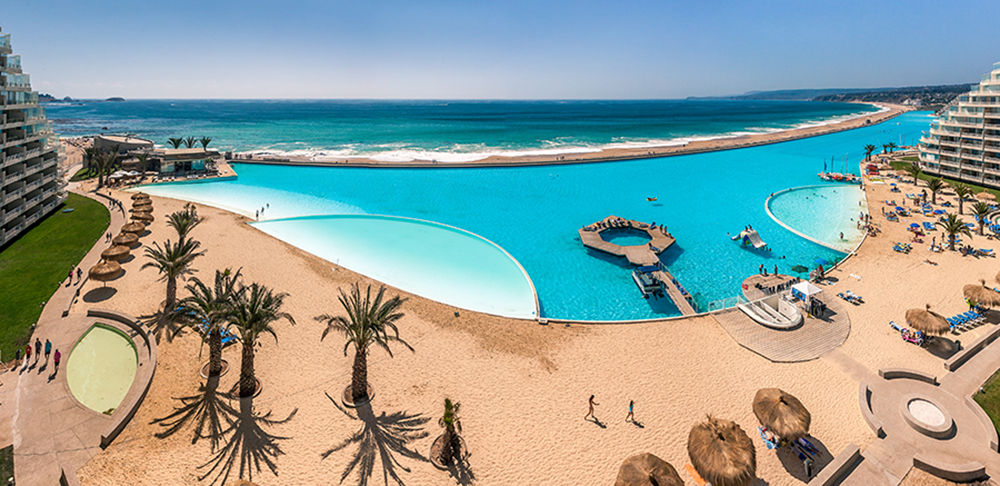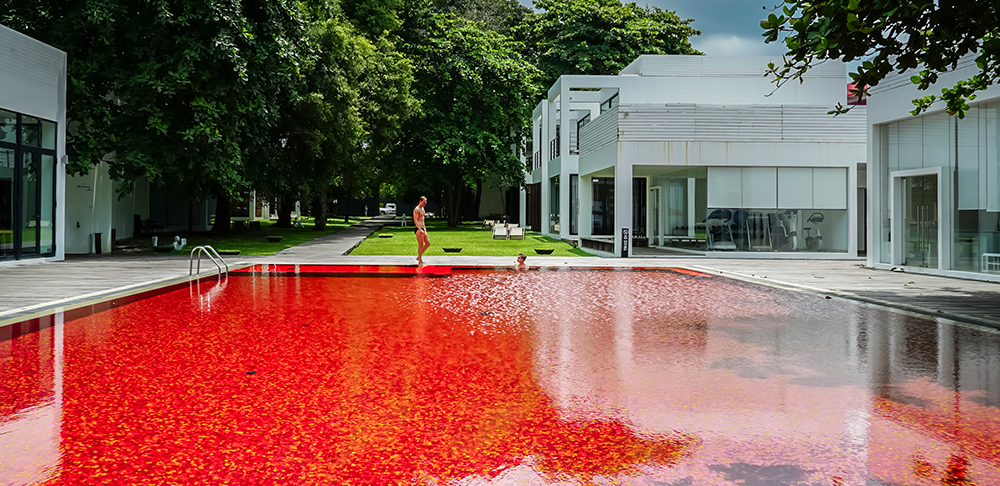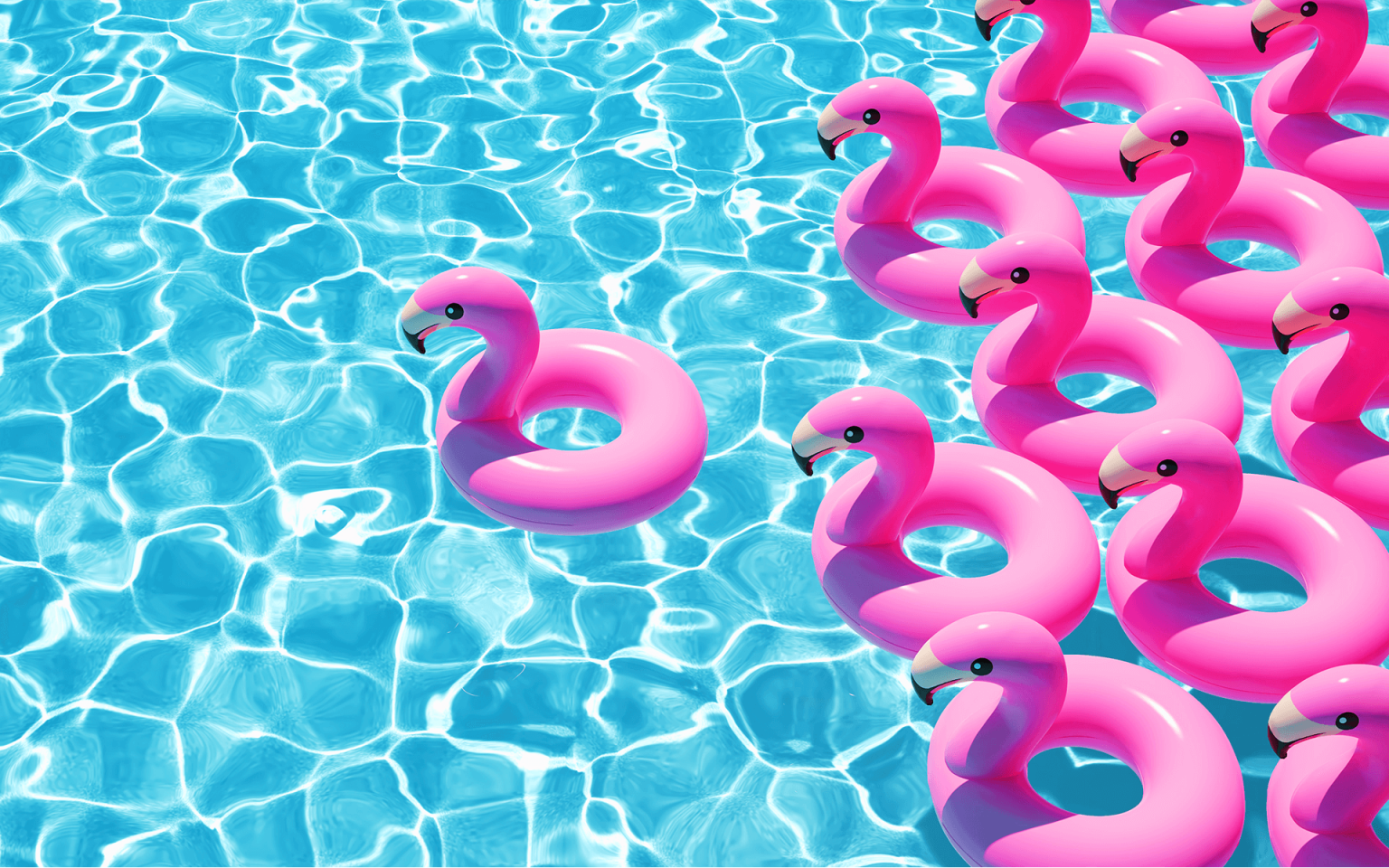7 Unusual and Fun Facts About Swimming Pools
For a little bit of fun, we thought we’d put our swimming pool expertise to good use and compile a list of our favourite fun and unusual facts about swimming pools. Why not, right?! Read on below to enlighten yourself with some interesting tidbits about swimming pools that will make for great conversation starters around the dining table.
1. The biggest swimming pool in the world is 20 acres large

Yep, 20 acres. That’s about the size of 16 football fields. The largest pool in the world is in Algarroba, Chile and cost close to $2 billion to build back in 2006. Holding an enormous 66 million gallons of water, stretching 1,013 metres long and going as deep as 35 metres in some sections (that’s approximately 12 stories), the pool is a part of the San Alfonso del Mar resort and has a whole range of interesting features to it – including a pool within the pool, and a saltwater pool beside it housed in an indoor glass pyramid. As you can likely imagine, the pool is too large to swim across and requires travel by canoe, kayak or paddleboat if you want to get to the other side.
2. The oldest swimming pool in the world dates back to the Third Millennium BC
Now an archeological site, the oldest swimming pool in the world known as the Great Bath can be found in Mohenjo-daro, Pakistan. It was believed that the Great Bath was used for ritual bathing ceremonies and religious purposes like purification. The surprisingly sophisticated structure of the pool, as well as the presence of washrooms in residential structures nearby, tells historians and scholars that hygiene and cleanliness was likely important to Mohenjo-daro residents at the time.
3. The most popular accessory or add-on to a pool is (still) a diving board
A significant 38% of pools have diving boards, which make them the most popular add-on for swimming pools. However, a few decades ago this number might have been closer to 80%. So what changed? Pool safety laws and regulations have tightened up tremendously over recent years, meaning that a lot of manufacturers have phased out diving boards to avoid accidents and ensuing lawsuits. There’s also the issue of diving boards not even being an option in the first place – your pool needs to be a certain size in order for it to be eligible for a diving board installation, and cannot be an above-ground model. Lastly, there’s also the issue of homeowners insurance, which often goes up in response to the addition of a diving board to a swimming pool.
4. One of the first ocean liners to have a swimming pool was The Titanic
Yes, the Titanic was a landmark in a number of ways, and that seems to include being one of the first ships of its type to have a pool. The actual first was the RMS Olympic, which was widely considered to be a “sister” to the Titanic and set sail the year beforehand. The pools on both the RMS Olympic and the Titanic were heated and only available for use by first-class passengers, and were open at different times for men and different times for women. Known more specifically as the Swimming Bath on the Titanic, it was part of the Turkish bath complex on the ship and passengers had to buy a ticket to be admitted entry. If you’re a history buff, you might know it as the last room on the bow of the ship to flood as it went down!
5. The Olympics get pretty serious when it comes to their swimming pools
Swimming was brought on as one of the original 9 official sports at the first modern Olympic Games in 1896, and ever since then Australia has enjoyed most of its Olympic medals in that category, with a total of 208 won – among those include 9 from Ian Thorpe and another 9 from Leisel Jones. Originally the swimming competitions were held in the Mediterranean Sea, but this all changed at the London Games in 1908 where the first Olympic swimming pool was built. Today, Olympic-sized pools can hold an enormous 850,000 gallons of water, which equals roughly 3.8 million litres. While they are always 50 metres long, when it comes to width they can vary, going up to 25 metres.
6. The Ancient Egyptians loved to swim
It’s true – it seems like swimming for leisure has been enjoyed by cultures from all over the world for millennia. Ancient wall drawings in Egypt dating back to 2500 BC depict people swimming, specifically using an over-arm stroke comparable to the front crawl. Swimming was something the noble folk enjoyed, with swimming lessons for young royal children being encouraged. While some suggest the common folk would practice swimming in the River Nile (though it’s contentious, as the Nile was infested with dangerous animals), royals and noblemen enjoyed swimming in private swimming pools in their palaces.
7. The weirdest pool in the world goes to…

Calm, blue ocean waves are commonly simulated in cerulean swimming pools, so this pool is particularly shocking when you lay eyes on it. A beachfront hotel in Koh Samui, Thailand uniquely named The Library has a similarly unique pool, with waters of a confronting blood-red colour. Interestingly, the red colour doesn’t come from the water itself, but rather from the intricate red mosaic tiling used when building the pool. P.S. If you’re a bookworm, you might enjoy the fact that the resort lives up to its name, showcasing a 1,400-book library.
So, there’s our range of factoids and interesting stories about pools for you to pull out next time the topic comes up in conversation. Whether it’s history, geography, sports or just oddities, there’s a whole realm of interesting stats and information when it comes to swimming pools. We’re some of Australia’s leading experts in the field, after all.
Want to make better use of our knowledge and chat about getting your own pool installed? Contact us today to chat through your options.

